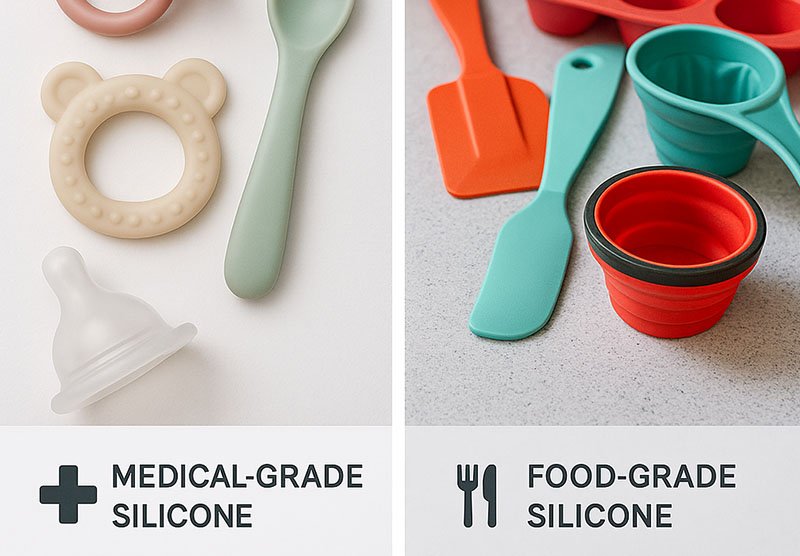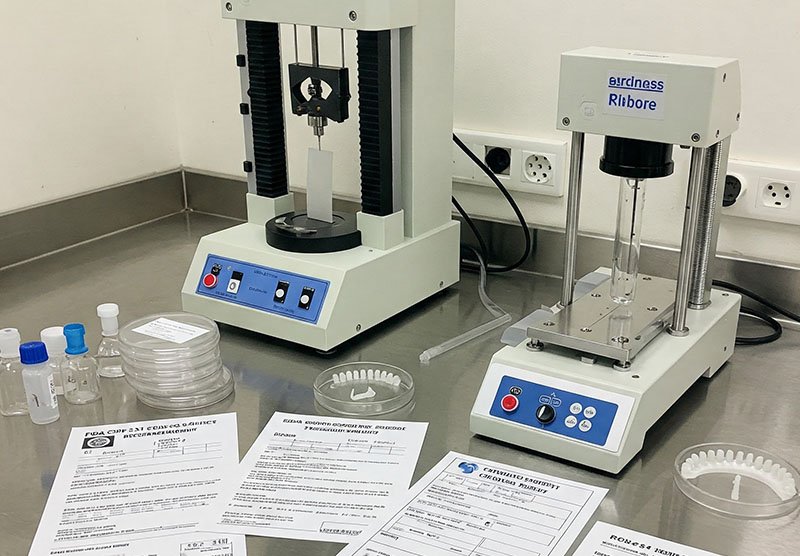Ever heard a supplier casually say, “Yeah, this is food-grade silicone”—without any paperwork or test results? Yeah, me too. And it’s exactly how products get banned, recalled, or rejected at customs.
Food-grade silicone is a high-purity silicone tested to ensure it won’t leach harmful chemicals into food or drink. It’s odorless, tasteless, non-toxic, and complies with strict safety standards like FDA or LFGB. Other types of silicone—like industrial-grade or general-purpose—may look the same, but they can contain fillers, peroxides, or additives that make them unsafe for contact with consumables.
Long story short: food-grade silicone is safe enough for your baby. Industrial silicone? Not even safe for your coffee mug.
What Makes Silicone “Food-Grade” in the First Place?
Not all silicone is created equal. The food-grade label isn’t just marketing fluff—it’s earned through rigorous testing.
To qualify as food-grade, silicone must meet standards set by organizations like:
- FDA (U.S.) – 21 CFR 177.2600
- LFGB (Germany/Europe) – Includes stricter taste and odor tests
- BfR (Germany) and other regional authorities
That means:
- No plasticizers or heavy metals
- No smell or taste transferred to food
- Non-reactive under high heat or cold
- Tested for extractables, migration, and toxicity

Key Differences: Food-Grade Silicone vs. Industrial-Grade Silicone
Let’s break it down like a true silicone nerd. Here’s how food-grade silicone compares to other common types:
| Feature | Food-Grade Silicone | Industrial-Grade Silicone |
|---|---|---|
| Purity | High (no fillers or peroxides) | May contain additives |
| Certification | FDA, LFGB, BfR compliant | Usually none |
| Safety | Safe for food/babies | Unsafe for food contact |
| Color | Often clear or colored with safe pigments | Can yellow or off-color |
| Smell | Odorless | May have rubbery or chemical smell |
| Cost | Higher | Cheaper |
At Ruiyang, we never mix the two—because nothing kills trust like a “food-grade” product that fails a migration test.
What About Medical-Grade Silicone—Isn’t That Even Better?
Yes, and no.
Medical-grade silicone is even more rigorously tested—biocompatible, USP Class VI certified, and safe for prolonged skin or body contact.
It’s used in:
- Baby pacifiers
- Menstrual cups
- Surgical tubing
But do you need it for spatulas or baking mats? Not really. It’s overkill for kitchenware and significantly more expensive.
If you’re targeting premium baby products, it’s a great option. Otherwise, FDA or LFGB food-grade is more than enough for most kitchen or food-related applications.

The Dangerous Game of “Fake” Food-Grade Silicone
This is the dark side of sourcing from unverified suppliers.
Some factories use:
- Peroxide-cured silicone labeled as food-safe (it’s not)
- Fillers like chalk to reduce cost
- Non-food-safe pigments to make it look pretty
Worse, they flash a fake FDA logo on their Alibaba page and hope you don’t check the paperwork.
At Ruiyang, we’ve seen entire Amazon stores go down due to product bans—and it wasn’t even their fault. Their supplier lied.
My advice:
- Always request full test reports (not just an “FDA” stamp)
- Verify the lab’s credentials
- Ask if the entire product or just the raw material was tested
Want to be 100% sure? Ask us for dual FDA + LFGB certified material—we’ve got it in stock.
Applications: When to Use Food-Grade vs. Other Silicone
Choosing the right type matters—your end-use decides everything.
Use Food-Grade Silicone For:
- Baking mats
- Baby spoons
- Food containers
- Ice cube trays
- Coffee machine gaskets
Use Industrial-Grade Silicone For:
- Automotive gaskets
- Electrical insulation
- Industrial tubing
- Mechanical seals
- Weatherstrips
Using industrial silicone in a food product is not just risky—it’s illegal in most markets. Don’t risk your brand’s reputation over a few cents saved.
What We Offer at Ruiyang: No Guesswork, Just Certified Products
We’ve been doing this since 2012. With over 100,000 pieces of silicone products output daily, we’ve learned a thing or two about quality.
Our promise:
- Only certified food-grade silicone for kitchen and baby use
- In-house QA team + third-party lab verification
- Option for LFGB + FDA double compliance
- Color-matching with food-safe pigments only
- Full traceability from raw material to final product
You don’t need to guess. You just need to ask. We’ll show you the paper trail—and even video the production if you want.

More Related Questions
Is food-grade silicone safe for baking?
Yes! It can withstand 230°C or higher, depending on the formulation.
Does food-grade silicone turn yellow over time?
Only if exposed to UV or certain oils. We add stabilizers to prevent that.
Is there a taste or smell to silicone products?
Food-grade silicone should be odorless. If it smells, it’s probably not pure.
Can I get custom shapes made with food-grade silicone?
Absolutely. We do custom molds, colors, and even logo embossing.
Conclusion
Food-grade silicone isn’t just a buzzword—it’s a certification, a process, and a commitment to safety. If you’re importing, selling, or branding silicone kitchenware or baby products, don’t take shortcuts. Use certified material, check the paperwork, and partner with someone who knows the difference—like us.